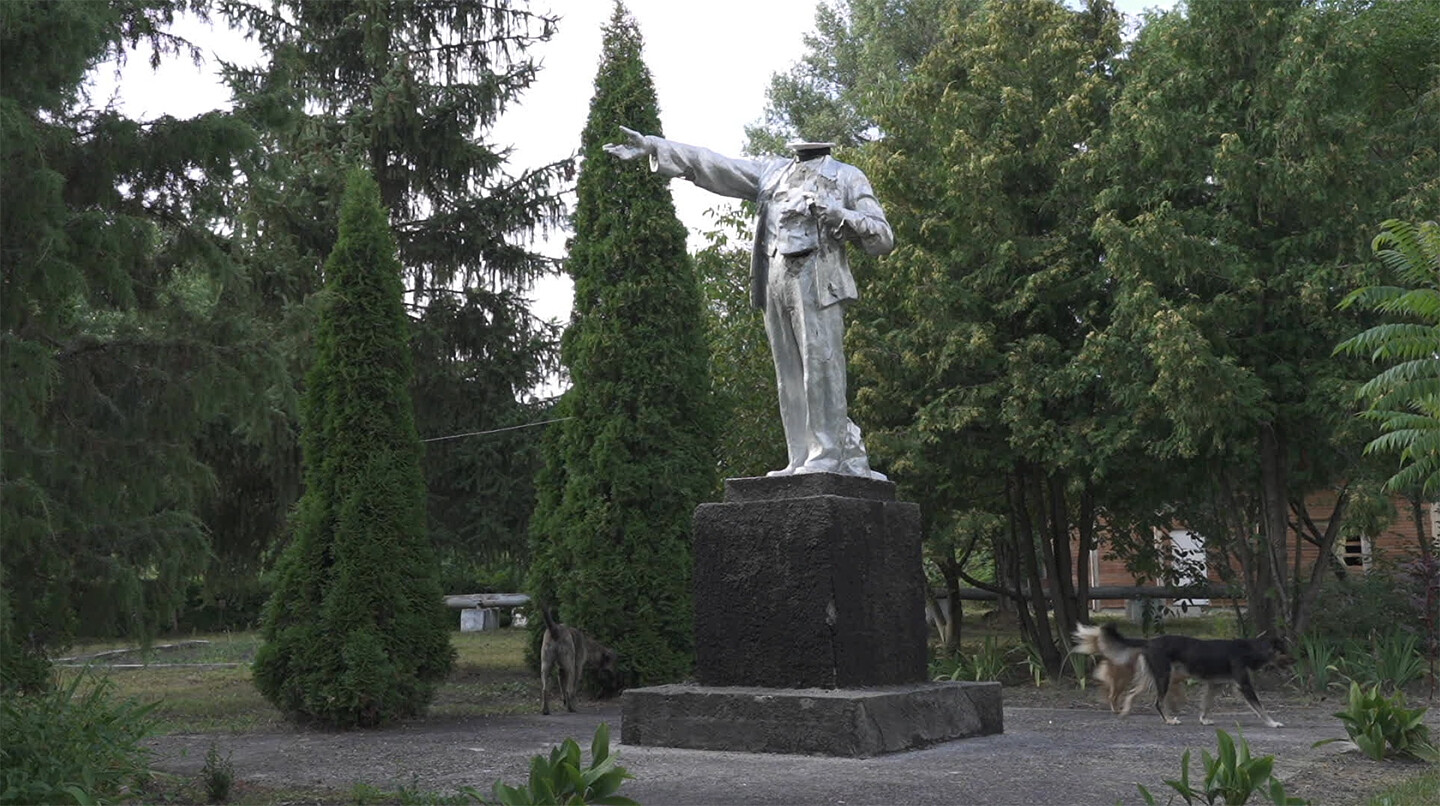There was a time—I still remember it—when it seemed we would escape “the gravitational pull of the [all-out] war.”1 But then, in January of last year, President Biden allegedly said in a phone call with President Zelensky that Russia’s military incursion was “imminent.”2 When media reports of the phone call surfaced, the war started looking more real. There is no perfect analog to “imminent” in Ukrainian, so the word caused confusion. For example, computer-assisted translation software (CAT) translates it as “nemynuche,” which in English is closer to the word “inevitable.” One major Ukrainian publication used this translation, which was then reproduced and disseminated by others.3 Suspended between “pending” and “inevitable,” an all-out war—no matter how proximate—still seemed avoidable, until everything accelerated on February 11, 2022. That day, news about a declassified US intelligence report went viral. The message was this: a full-scale war will break out on February 16.
This announcement contradicted the regime of the then-eight-year-long unannounced war—that is if we start counting from mid-2014, when the Russian Federation annexed Crimea and began construction on the Crimean Bridge (linking the Taman Peninsula in Krasnodar Krai, Russia with the Kerch Peninsula in Crimea), or several months later, when Russian forces entered the Donetsk and Luhansk regions of Ukraine. Looking back from today, signs of the potential imperial expansion were visible decades earlier. For example, in 2003, the Russian Federation initiated a territorial dispute over Tuzla, a sandy island off the coast of the Crimean Peninsula that had separated itself from Russian territory quite naturally through a three-hundred-year-long geological process of erosion,4 until a massive storm finalized the split on November 29, 1925 (after which it was transferred to the Ukrainian Soviet Socialist Republic’s jurisdiction and then subsequently to Ukraine after the dissolution of the Soviet Union). The island became a dangerously seductive stepping stone for the empire’s “adversarial infrastructures” of the future.5 Despite mounting signs of a looming invasion, the announced beginning of the ongoing unannounced war was thus postponed.
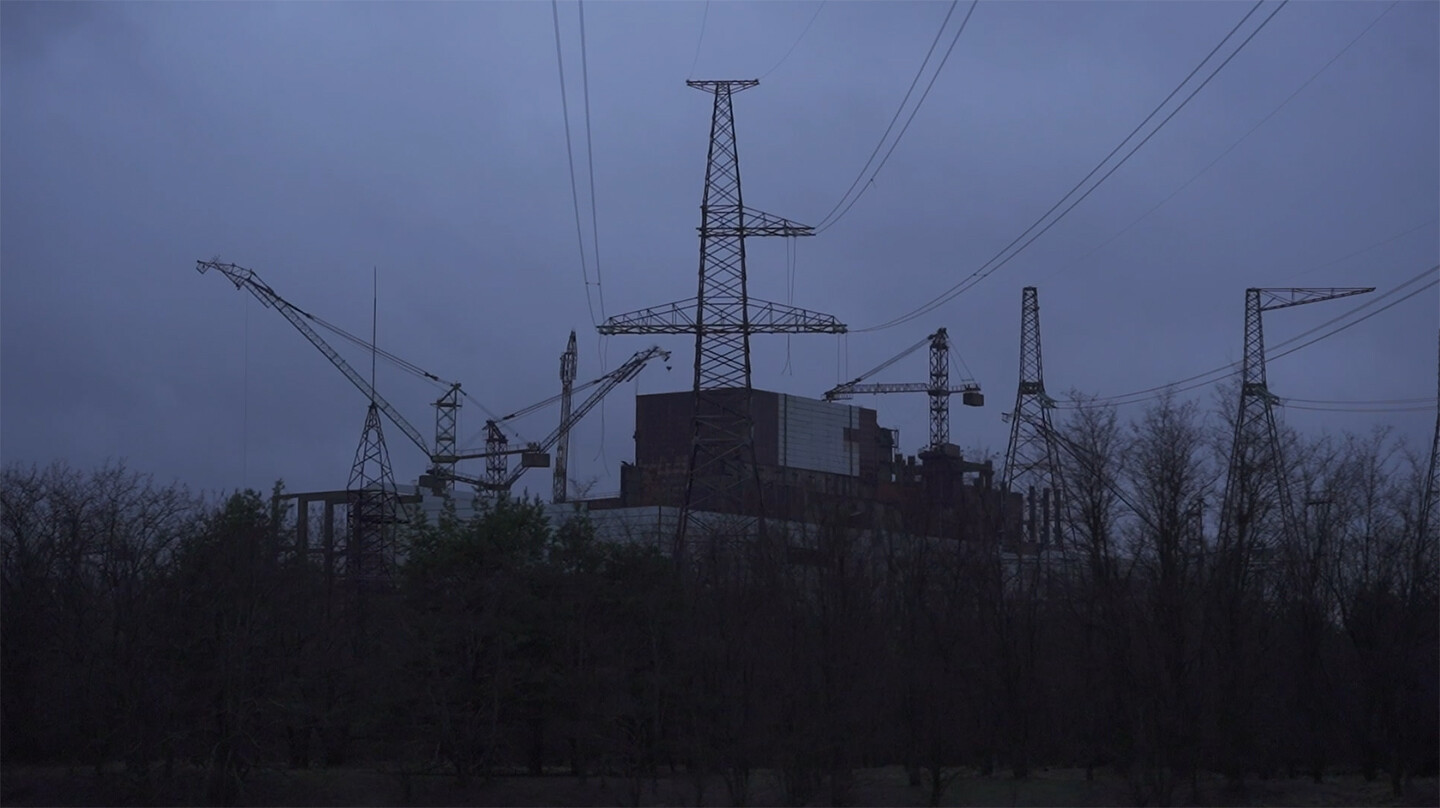

Still from Chornobyl 22, a documentary film by Oleksiy Radynski, 2023. Camera: Max Savchenko.
Every day in my town before the announced invasion, we were suspended between a paranoiac sense of certainty about the upcoming invasion—all the dots connected, all the signs were there—and the disturbing uncertainty created by a deficit of knowledge that always emerges in states of data overload. Under such conditions, meaning disintegrates and comprehension is subverted by an overflow of conflicting information. After the postponed invasion, however, the gap between what I thought I knew and how I started acting upon that knowledge started closing fast. Reality imposed itself on me, on us, as a mixture of fiction and nonfiction, with one of them overwriting the other: disseminated maps of bomb shelters, most of them nonexistent; the formation of local groups for territorial defense without a clear agenda; people in military uniforms, still without weapons, populating the streets; me filling online shopping carts with items for my emergency backpack, without buying them. I resisted the idea of the impending all-out war, which was the only form of resistance available until other forms of resistance became necessary.
“Let’s say this is a game,” I thought in early 2022, speculating about intelligence projections and wondering where the Russian state would stop at demonstrating its alleged martial capacities near the Ukrainian border. How far would the Russian Federation go before militarization spread across every inch of the fabric of our everyday lives, shaking and destroying all our life-supporting relations and energies? I thought their senseless waste of these energies and ruptures of these relations were already profoundly immoral acts. I thought this would be the worst of what people in Ukraine would have to live through in 2022—the irreversible militarization of life in proximity to something impending, looming, and threatening. Since March 2021, the massive accumulation of Russian forces on the Ukrainian border had pulled the entire country back and forth, exhausting us in waves: at high tide was the constant threat of all-out war, at low tide a less-intensive disturbance in the east.
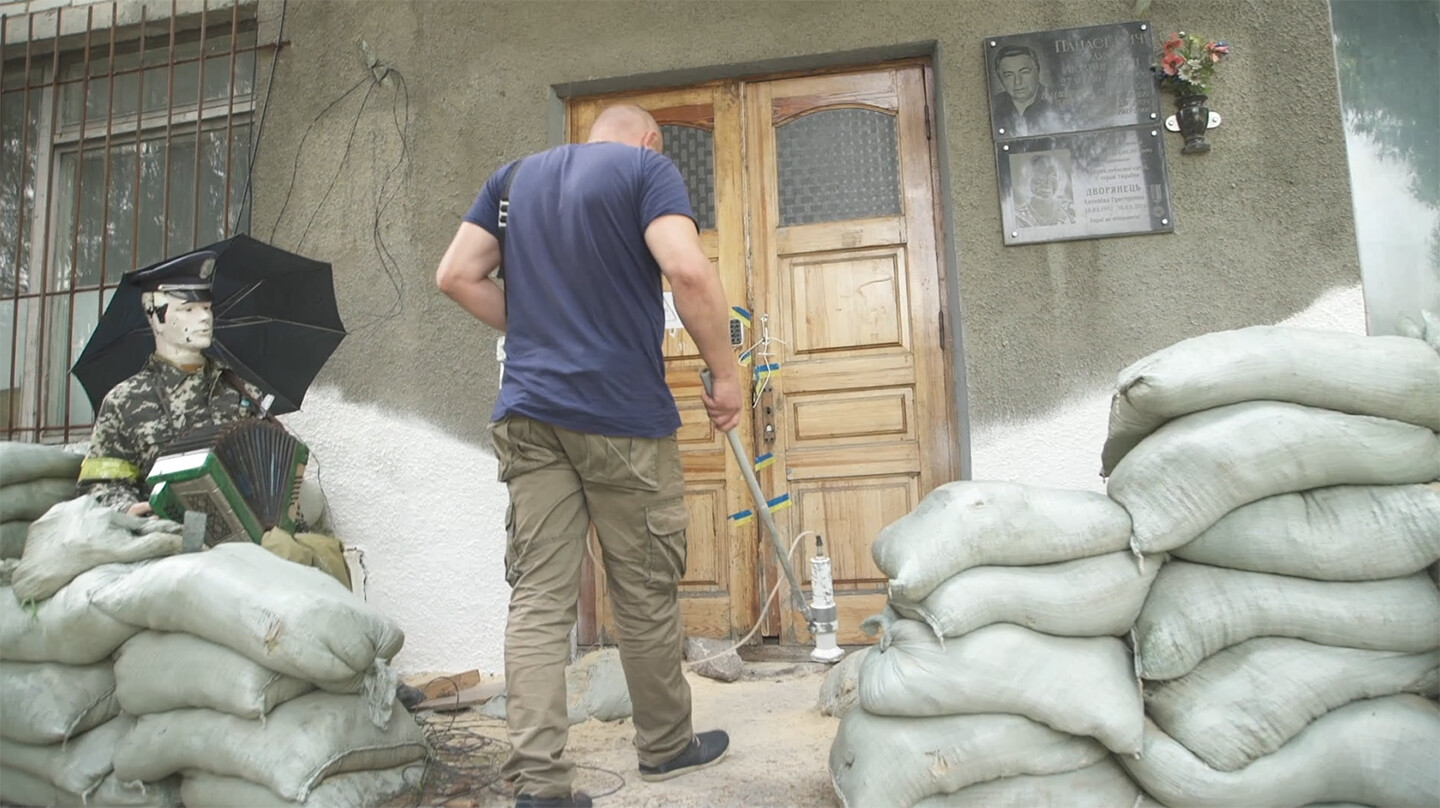
Still from Chornobyl 22, a documentary film by Oleksiy Radynski, 2023. Camera: Max Savchenko.
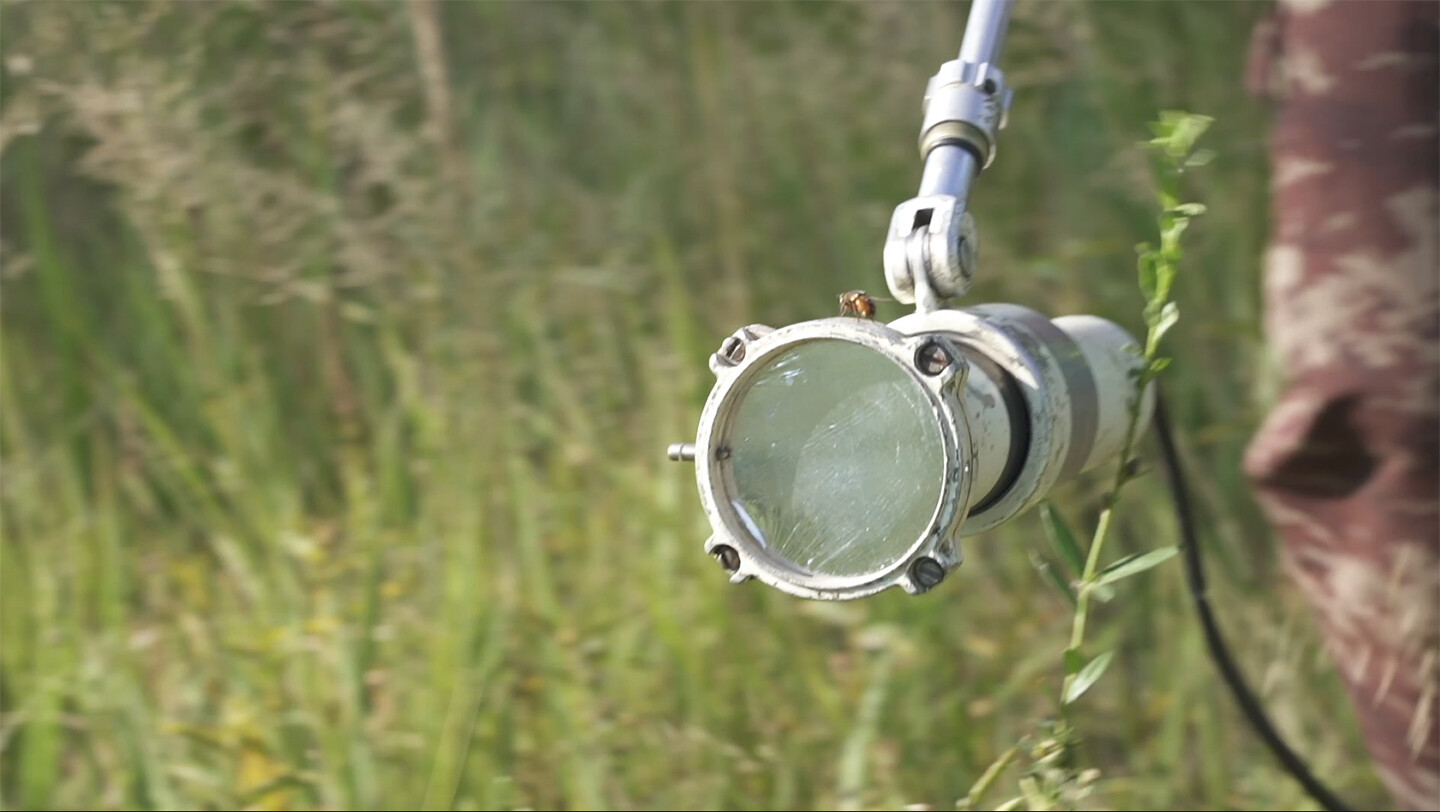
Still from Chornobyl 22, a documentary film by Oleksiy Radynski, 2023. Camera: Max Savchenko.
Still from Chornobyl 22, a documentary film by Oleksiy Radynski, 2023. Camera: Max Savchenko.
The day before the announced (yet postponed) invasion last February, I asked a friend if I could observe our local territorial defense group’s training sessions “for research purposes.” Two days later, we were in a cab heading toward the outskirts of town. A man with a bag of weapons was waiting for us on the side of the highway. Throwing the bag over his shoulder, he led my friend and I down a muddy trail until we reached, in ten minutes or so, something like a polygon. The man put the bag down carefully. He pulled out helmets, yellow ballistics glasses, tactical headsets, and bulletproof vests, and swiftly wrapped our bodies in all of it. My neck and shoulders gave in under the weight of the equipment while I tried to follow the instructor’s lecture. Every item in your backpack must be multipurpose; war demands self-care and augments the danger of even the smallest scratches; war is primarily about debris, and only secondarily concerns bullets, rockets, and bombs. In the next three to four hours I learned how to disassemble, assemble, and aim an AK-47. Then, released from the vest and heavy combat helmet, I cabbed back home with a sense that life had already been irreversibly pulled into a disastrous cybernetic vortex by forces impossible to resist. The war, I finally realized, was imminent in the sense of inevitable. Martial assemblages6 had formed long before they revealed themselves for documentation.
As political theorist Jairus Victor Grove reminds us, war is a life-form that subsists on rot and regeneration. War decomposes the relations and assemblages that sustain peaceful life, and replaces them with martial relations and assemblages that sustain life during conflict.7 I could not have previously imagined that within just thirty days, scores of martial assemblages, the extensions of war, would proliferate epidemically. I couldn’t have fathomed that Ukrainians would witness—by reading, watching, hearing, seeing, feeling, and sensing through torture—the “borderless” empire breaking into a sovereign territory by means of genocidal and ecocidal destruction, violently territorializing itself,8 driven by its imperial identity crisis: a delusional quest for its “lost kingdom.”9
The war progressed throughout the spring and summer of 2022, advancing deep into territories that were still far away from the front lines. It expanded itself by proliferation: as Grove writes, multitudes of martial assemblages, beyond just “soldiers, tanks, uniforms, gas masks, … and bullets” are crucial “to move [war] from the abstract to the concrete.”10 My tenth-floor flat turned into a camp site. A wireless radio sat on my desk. All around me were stacks of canned food, four camping lamps, several headlights, bottles of horilka, two camping stoves, propane-butane canisters, four power banks, ten five-liter water bottles, boxes of candles, FFP1 masks that shield lungs from fine and solid particles, and, of course, iodine pills. These objects, gathered in response to new, threatening developments from the enemy’s military, entered my space gradually. But soon enough they formed an “intensive fabric of relations”11 that occupied my immediate surroundings, proving that the exteriority of a hypermodern nuclear cyberwar12 is imaginary—and that its proximity, to anyone anywhere, is real.
Terror Environments
The Russian government justified the full-scale invasion of Ukraine, in which the imperial state exercised its right to kill on the territory of another sovereign state, as a necessary “special operation,” aka a “state of exception.”13 It remains illegal in Russia to call this war a “war.” The Russian Federation would not even describe its actions as a blitzkrieg, which still implies conduct in accordance with the laws of war. A “state of exception” designates warfare without clear definition, employing unconventional techniques.14 In this regard, the Russian state’s description of its war as a “special operation” is accurate: it declares its intention to transgress the laws of war by opening space for unregulated war crimes, for creating multiple terror environments marked by extreme suppression and violence.
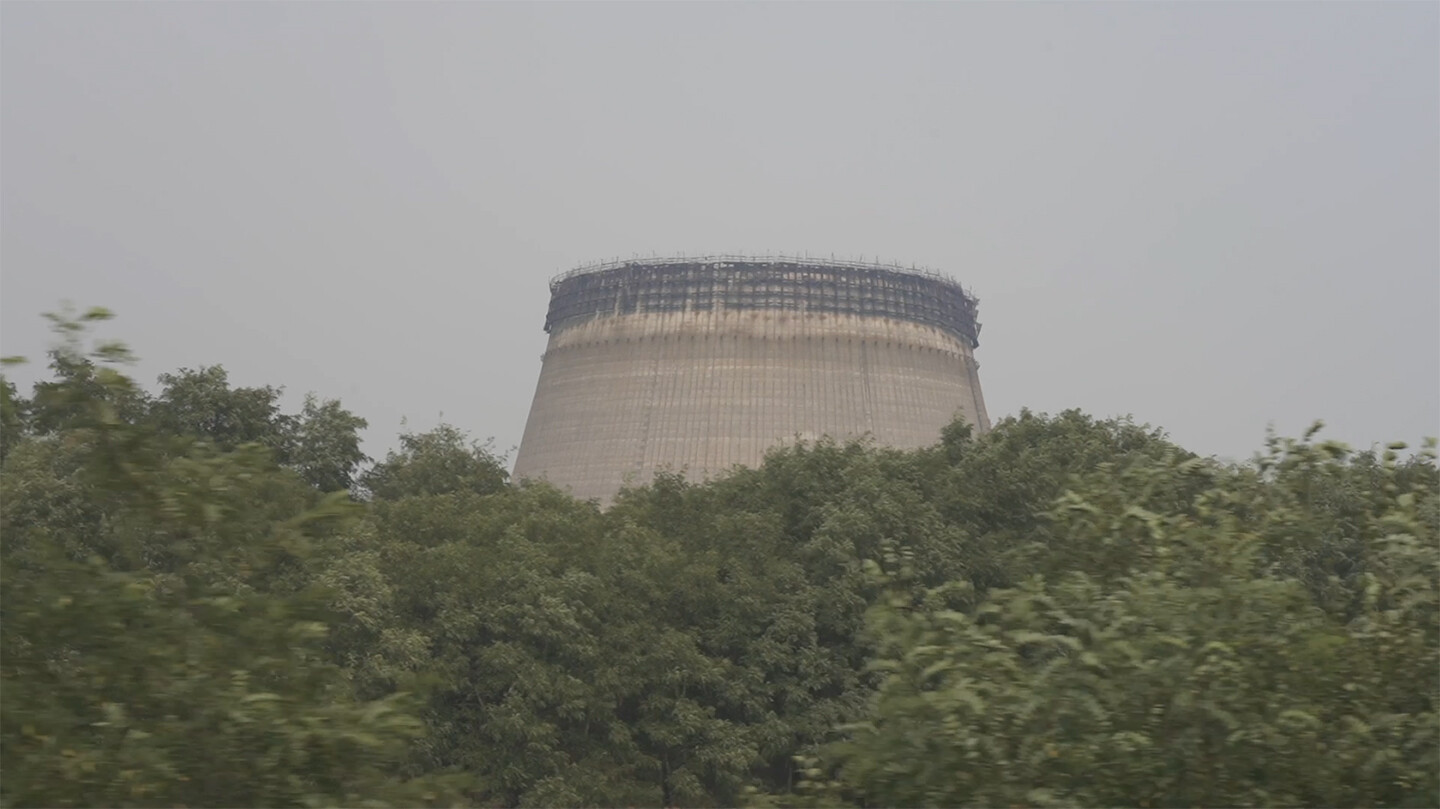

Still from Chornobyl 22, a documentary film by Oleksiy Radynski, 2023. Camera: Max Savchenko.
The terror environments of the present war are characterized by a simultaneous double targeting of Ukraine’s population by weapons and by information.15 The disinformation and propaganda generated by Russian state-controlled media have attracted significant international attention. This coverage, however, has mostly focused on the internal vector of Russian disinformation and its impact on the citizens of the Russian Federation. Related media discourse has remained stuck in 1930s and ’40s propaganda studies, centered on a unidirectional, behavioristic, hypodermic-needle model of the state injecting “lies, lies, lies” into its population.16 The communication model of Russian propaganda today is more complex than the model described by theorists nearly a century ago, although it still feeds on the basic principles of “crystallizing public opinion.”17 Now the theater of Russian propaganda exhibits a paradoxical mix of Ancient Greek drama and Christian salvation myth—thus the 2018–20 erection of a bizarre Main Cathedral of the Russian Armed Forces in the Moscow region. The building’s designs initially included a gigantic mosaic depicting Vladimir Putin, Sergey Shoygu, other high-ranking Russian officials, and Joseph Stalin.18 The chorus of TV propagandists both produces and channels the anxiety associated with a sense of destiny: “It’s better not to be born!”19 This paraphrased “wisdom” from Silenus, the companion and tutor of the wine god Dionysus in Greek mythology, is resurrected in an authoritarian state that supplies its audience with techniques to manage their relationship with truth by reducing it to a pure place. This place is sporadically occupied, depending on circumstances, by drastically shifting versions of reality, without causing any cognitive dissonance. What matters is that all versions are annunciated from the same place of power, where a convenient deus ex machina or his double in an expensive jacket offers a cheap performance to persuade the audience that he takes every individual sin upon himself. The mantra “This is Putin’s war” captures the gist of this social contract.
The external vector of Russian disinformation that reaches into the Ukrainian media sphere has not received sufficient attention, but it is a significant factor in the formation of terror environments. Every rocket attack, every reported case of extreme torture, every documented case of genocide is followed by denial and mockery on Russian state TV and associated social media channels. This content is disseminated so broadly that the double-targeted Ukrainian subject of the war has almost no chance to avoid such harmful and traumatic encounters. Viewers abroad are partially shielded from horrific war content courtesy of the algorithmic customer care of online media platforms, which is still performed by underpaid human contractors.20 Meanwhile, Ukrainians watch and produce their own horrific content, collecting witness accounts as evidence of war crimes in the hope of future justice—that is, if the Hague’s International Criminal Court can handle such an overwhelming archive. Ukrainians are forced to defend these irrefutable records of war atrocities against orchestrated accusations of “fakeness.” The most notorious examples of this include media campaigns to sow doubt over the Russian bombing of Maternity Hospital No. 3 in Mariupol in spring 2022, and over evidence of the Bucha massacre, which came to light after Russian forces withdrew from the Kyiv region. The genocidal jokes of Vladimir Solovyov, the Kremlin’s chief propagandist, have by now become mundane. This is not information war as we once knew it. What we need to recognize here is a qualitative shift from disinformation practices to the strategic production of terror.
Terror environments are centered around necropolitical data-subjects, the human targets of ads and drones. Situated at the intersection of global information networks and local media networks, the data-subject is surveilled by both commercial and military technologies. Distinguishing between the two has become irrelevant during the Russia-Ukraine war.21 Terror environments proliferate through the creation of numerous spaces of interrogation in which Ukrainian citizens are categorized according to their usefulness for cyberwar machinery. Torture rooms located all around the temporarily occupied territories and filtration facilities on their edges22 are supplemented by a growing number of reeducation institutions for children. In these spaces, subjects’ digital data, such as social media communications, photographs, and documents, are cross-read together with their biometrics. Meanwhile, their physical bodies are searched for signs of “Nazism” such as tattoos, scars, or other bodily marks that could hint at the possibility of further exploitation. Other Ukrainian citizens are deported to Russian territory as either a labor resource—the Russian state is losing its citizens to war-related migration and battlefield losses—or leverage, in the case of negotiations and prisoner swaps. These necropolitical data-subjects are terrorized into becoming multipurpose resources for cyberwar. Torture rooms, for example, operate simultaneously as machines for extracting information from people, and as the mises-en-scène for Russian propaganda TV, which broadcasts information placed forcibly into the mouths and bodies of disposable war subjects. These subjects are compelled to articulate messages or confessions by means of electric current, water torture, rape, hunger, broken bones, and cut flesh.
Terror environments expand extensively and immediately in size—from a room to a region and a country. Air-raid sirens, a constant in the Ukrainian soundscape since the end of February 2022, have generated myriad affective relations between different life-forms throughout the entire country. The sirens maintain a profoundly cybernetic form of control and communication in the animal and the machine. Martial assemblages also determine the temporality and spatiality of terror environments. On February 24, 2022, the enemy chose radar units as the target of its first blow. Radar is good at detecting cruise missiles that fly at low altitude, with a relatively slow speed of under one thousand kilometers per hour. The Ukrainian defense system has about fifteen minutes to intercept such missiles; the reported interception rate is 70 to 75 percent. One of the most common tactics of the Russian forces has been to overwhelm the Ukrainian air defense system with a barrage of rockets. Some of them manage to break through. When Russian forces use ballistic missiles, some of which can fly beyond the atmosphere at hypersonic speeds of up to nine thousand kilometers per hour, the window for interception is only a few seconds. This of course makes them much harder to shoot down. And then there is debris. Over the past year, my thoughts have often returned to my bewildering military training session before the full-scale invasion. Exploding debris, my instructor said, defines your immediate surroundings more than bullets do. Since then, while remaining affectively linked to thousands of others in Ukraine by the wailing sound of alarms, I would often visualize the contours of the space formed by multitudinous trajectories of flying debris—all those pieces of glass, metal, and concrete that a shock wave may, one day, carry through my apartment in nanoseconds, leaving me no place, nor time, to hide.
Nuclear Cyberwar
War analysts acknowledge that the ongoing Russia-Ukraine war has employed tactics and strategies from both World War I and World War II. The conflict is, at one and the same time, a trench and artillery war and an aircraft war: computation is merged with antiaircraft fire, battlefield strategies are assisted by probabilistic calculations. This is also a cyberwar which, apart from the “kinetic” use of helicopter gunships, artillery, rocket batteries, tanks, small arms, and other conventional weapons, also involves electronic command, control, communication, and weapons-targeting systems.23 All of this is now amplified by signal and open-source intelligence, aerial and ground-based intelligence, and monitoring and analysis of social networks with or without special software. Ongoing cyberattacks and hacks have been consistent with conventional definitions of cyberwar, but the present conflict has also marked a turning point for pilotless aircraft. This development takes the notion of “cyber warfare” to another level.


Still from Chornobyl 22, a documentary film by Oleksiy Radynski, 2023. Camera: Max Savchenko.
Both Russian and Ukrainian forces employ drones for surveillance, guiding artillery fire, dropping weapons, jamming local cellphone towers, and sending threatening messages to enemy soldiers, known as “SMS bombing.” Apart from their extensive application on the battlefield, drones have been used by the Russian army to terrorize and bomb Ukrainian civilians. The United States has led the charge in deploying tactical drone warfare, consistently carrying out drone strikes in Pakistan, Afghanistan, Yemen, and Somalia as well in the Gaza Strip and now in the West Bank of Palestine.24 Presidents Bush and Obama together oversaw 620 strikes outside the active war zones of Iraq, Afghanistan, and later Syria, with Obama overseeing more than five hundred drone strikes throughout the Middle East, which, according to the Bureau of Investigative Journalism, killed four hundred to eight hundred civilians.25 The Russian state exploits the grimmest legacy of the US “war on terror” with its reluctance to admit the scope of systemic “civilian causalities.” It rejects the notion of “civilian causalities” entirely, reversing the logic of execution by remote strike. According to the Russian state and state-controlled media, there are no civilian causalities in this war. The secret logic behind such “success” is simple: the rocket, bomb, or grenade always arrives at its destination because its destination is where it arrives.
People across the country can distinguish the frequent, intense sound of these “deadly flying motorcycles” among other noises in the complex soundscape of this war. Armed civilians and city police have attempted to shoot down drones, though officials have discouraged this practice, insisting that air defense is the domain of the military.26 Even in relatively protected cities like Kyiv, low-flying or swarming drones equipped to resist hijacking can evade Ukrainian radar to drop bombs on civilian infrastructure. Since drones are significantly slower than missiles, they constitute the other temporal edge of the terror environment. In his address to the Russian Defense Ministry Board on December 21, 2022, the Russian president said that the IT and drone industries were a top priority in the coming year.27 His assertion that “the most effective weapons systems are those that operate quickly and practically in an automatic mode” signals further intensification. The overall use of drones in this war could soon shift from tactical to fully strategic.
The Ukrainian army is consistently short on heavy military equipment and technology; tanks and air defense systems arrive months later than expected. Integrating drones into more complex systems allows Ukrainian forces to contend with Russian forces in this asymmetrical war. This war has also presented a striking case—in scope and effectiveness—for the use of commercial technology. DJI Mavic “wedding drones” and “toy drones,” handheld two-way radio transceivers, cell phones and tablets, Google Maps, and Starlink stations form powerful military assemblages communicating data to artillery operators. While such technology provides vital “eyes” for Ukrainian forces, their surveillant gaze can easily be turned back on the same army due to a lack of data encryption. For example, the same Chinese company that produces commercial DJI drones also sells AeroScope, a radar drone detection system used by both sides. This radar identifies the flight path of a DJI done along with the location of the person operating it, which results in immediate artillery strikes. Ukraine, and certainly Russia too, has become a hackathon site for outfitting DJI drones with DIY, battle-ready capabilities like carrying a grenade and evading surveillance.
This is where the “cyber” and the “kinetic” overlap and amplify each other until it is difficult, or impossible, to distinguish between them. In the resulting “hybrid” cyber-conventional war, “the two elements either fully coincide or phase in and out during complex, asymmetrical military confrontations.”28 Even when it involves precision weapons and AI, twenty-first-century cyberwar is inconsistent with late-twentieth-century ideas of reduced kinetic combat. Instead, it demonstrates the combining of recent technologies with leftover munitions from WWII, including raffles and rockets, trenches and dirt. Other elements that we remember from Russian and Soviet war history remain: namely the reliance on an unrestricted supply of cheap, disposable human resources drawn from colonized first-nation communities and many strategically underdeveloped ethnic and social groups within the Russian Federation.


Still from Chornobyl 22, a documentary film by Oleksiy Radynski, 2023. Camera: Max Savchenko.
The current war exhibits another continuity between the wars of the twentieth and twenty-first centuries: all are “ecologized” wars. As Peter Sloterdijk wrote two decades ago, “The discovery of the ‘environment’ took place in the trenches of World War I.”29 Starting with the first use of “gas warfare,” the “atmoterrorist model” became the primary form of waging war for the next hundred years. “The 20th century,” Sloterdijk projected, “will be remembered as the age whose essential thought consisted in targeting no longer the body, but the enemy’s environment,” the “immediate atmospheric envelope.” Since “air and atmosphere [are] the primary media for life,” the main target for destruction becomes “the air milieu in which enemy bodies move, subject to their own breathing reflex.”30 The “atmoterrorist model” at work during the Russia-Ukraine war has, of course, a nuclear dimension. At the very outset of the full-scale invasion, we witnessed an unprecedented military occupation of nuclear power plants. First, within hours of the invasion, Russian forces entered the territory of the former Chernobyl Nuclear Power Plant, which is now a state-run, specialized enterprise for decommissioning the plant. Then, a month later, they occupied the largest nuclear power plant in Europe, the Zaporizhzhia Nuclear Power Plant. This became the center of an ongoing international nuclear safety crisis—more accurately described as an act of nuclear terrorism.31
Although Reactors 5 and 6 at the Zaporizhzhia Nuclear Power Plant were immediately shut down as a precaution when the invasion started, Reactors 1 to 4 were the site of two hours of heavy combat. It was later reported that a large-caliber bullet pierced an outer wall of Reactor No. 4 and an artillery shell hit a transformer at Reactor No. 6.32 These instances of nuclear terrorism threatened a full realization of the grimmest possible scenario: turning nuclear power infrastructure into a giant nuclear bomb. Soon after Russian forces gained control of the Zaporizhzhia premises, they created an information blackout by disconnecting cable internet and some mobile services around the site. As a result, the International Atomic Energy Agency lost access to real-time monitoring of radiation levels. This “atmoterrorist” environment at the intersection of cyber and nuclear war expanded far beyond the territory of Ukraine, proving again that there is no outside to this war.
The threat of international nuclear blackmail returned around the time of the full-scale invasion, when Putin put Russia’s deterrence forces, including nuclear weapons, on “special alert.” This order disregarded the Budapest Memorandum of 1994, which prohibited the Russian Federation, the United Kingdom, and the United States from threatening or using military force or economic coercion against Ukraine, Belarus, and Kazakhstan. Based on the security assurances made by the signatories to the memorandum, Belarus, Kazakhstan, and Ukraine gave up their nuclear weapons. The occupation of the Chernobyl and Zaporizhzhia power plants, and the subsequent weaponization of their infrastructure, is different from the nuclear blackmail of Putin’s order. The latter was mainly used to manipulate communicative dynamics between major international power players. Meanwhile, Ukraine has been demolished by shelling. And in mid-August 2022, we came closer than ever to a nuclear catastrophe when Russian forces attempted to disconnect the Zaporizhzhia Nuclear Power Plant from the Ukrainian power grid. This effort lasted until September 11, when, following a visit from an International Atomic Energy Agency delegation, the last working reactor was put on cold shutdown. The weaponization of nuclear energy infrastructure brings an important element of chance into play. Anything can happen, either by planning or negligence, which become indistinguishable in an information blackout.
Nuclear terrorism is one element of this ongoing, complex, asymmetric warfare. At least two vectors reveal its overdetermined nature. One vector is interimperial, and it concerns the aggressive processes of power redistribution between several major international players. Another vector is colonial-imperial, which primarily concerns the imperial relation that the Russian Federation, Soviet Union, and Russian Empire have long been imposing on their “others.” These include Indigenous peoples from Siberia to the far east and Arctic regions, various underdeveloped and federated communities, and other independent states of the former or current Soviet and Russian sphere of influence. The interimperial communication unfolds according to the logic of deterrence, understood as a threat or force applied by one party to convince another to refrain from initiating a particular course of action. While it is extremely aggressive, this is still a communicative exchange. The circles of such communication include different politico-economic transactions, and the communication is not meant to break down.
The global economy, a subject of interimperial dependency, strives to reboot itself even at the cost of significant transformation—all the while, however, keeping capitalist power relations intact. If there is anything we have learned—again—from the general slowness and insufficiency of economic sanctions against Russia, it is that there is nothing solid left of solidarity. National interests remain of primary importance. Since the list of countries that retain economic relations with Russia after a year of genocidal war remains long,33 the role of the “Russian Empire” (as Russian state officials proudly identify “their” country), among other former imperial powers in this economic assemblage, is peculiar. Its extreme extractivism and exploitation serves the fossil-fuelled capitalist interests of the so-called West and its simultaneously “oil-soaked and coal-dusted” democracy, as Cara Daggett puts it.34 They say nobody wants to know what’s on the other side of the pipeline. In reality, what’s at stake here is not ignorance, but convenience. Everybody knows what is on the other side of the pipeline. “Your corruption is our economy,” one European politician communicated to a Ukrainian government official not long ago. So are your practices of exclusion, segregation, repression, and extreme extractivism. It is not hard to guess that this message is often passed to those corrupt, authoritarian, totalitarian, and now fascist regimes that “have historically been part and parcel of the project of securing Western (fossil) rule.”35 The undemocratic, authoritarian state has things to offer to the so-called West. And the West provides added value by legitimizing (and perpetuating) the violent, repressive politics that sustain fossil-fuel fascism.36 It is a transaction.
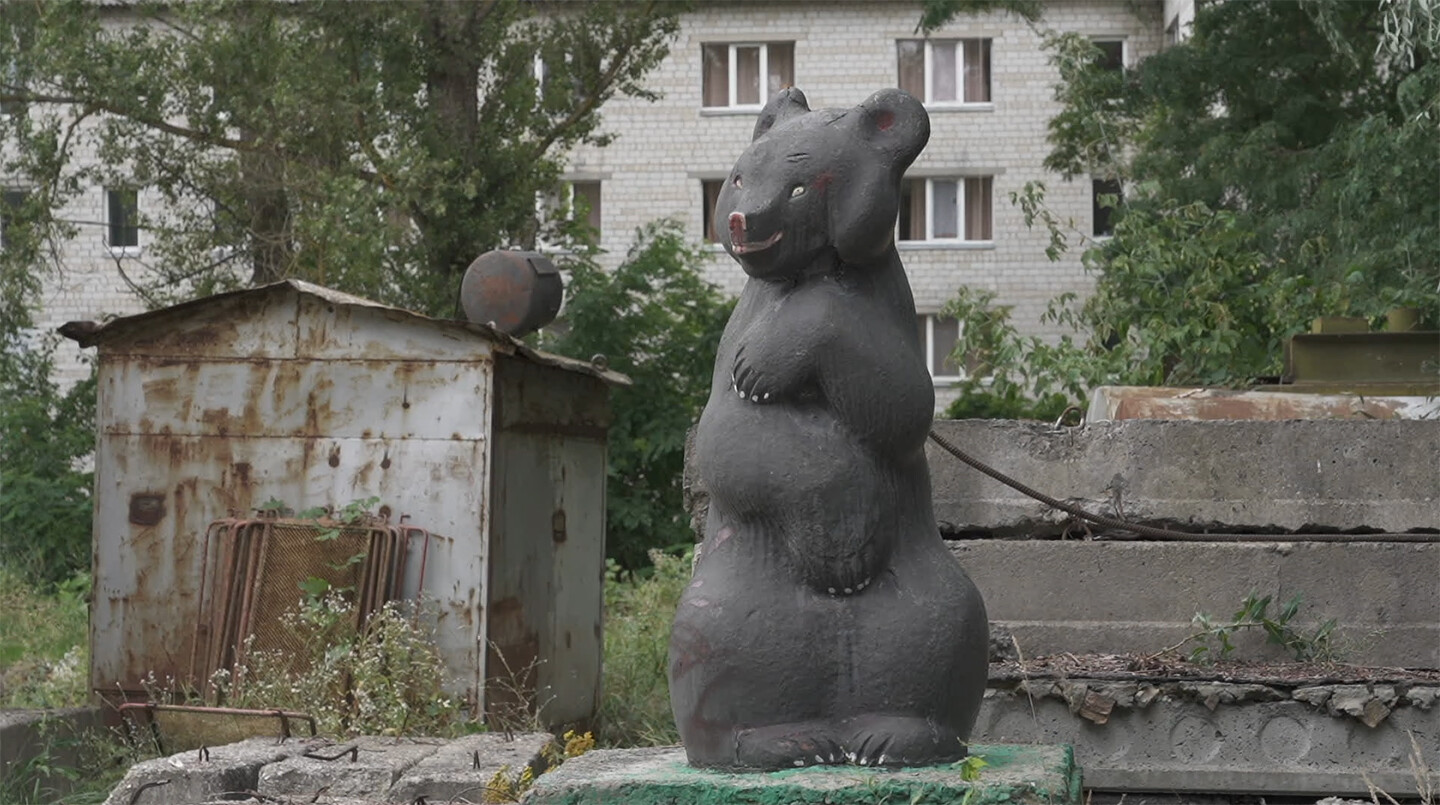

Still from Chornobyl 22, a documentary film by Oleksiy Radynski, 2023. Camera: Max Savchenko.
Unlike the uninterrupted communication of the interimperial vector, the colonial-imperial vector is a trajectory of noncommunication. It sets the direction for relations of suppression, subsumption, annihilation, and erasure. All negotiations are suspended indefinitely. “Ukraine does not exist” for the Russian state as a party in negotiations, except as an imagined subaltern who must submit to the invader’s will. These communicative realities do not meet. And those who propose various negotiation plans must seriously account for this broadly mobilized and propagated psychotic vision. To listen to Putin, the existence of the Ukrainian state undermines the conception of Russian identity envisioned by the state’s ultraright ideologues. As fascists often do, they draw linkages to the past, specifically in this case to the medieval state of Kievan Rus. We are often reminded today that “empires do not know their borders.” This speaks of ultimate uncertainty, and thus of the imperial urge for conquest, which is driven by paranoiac imperial certainty about a threatening outside. The Russian Federation claimed that they “had no choice” but to invade Ukraine and kill its people, which constitutes a complex and contradictory epistemological landscape that could probably only be deciphered through psychoanalysis. This urge, ever embittered by an extreme resentment that will only grow in the future, is particularly strong in those citizens of the Russian Federation who already feel—or will feel very soon—that whatever future they thought they had in Russia has been stolen from them. This mass vision of a stolen future will remain one of the many dangerous consequences of this war, no matter what awaits the Russian Federation in the years to come. It will also serve as a resource for future fascist mobilizations.
This same noncommunication sustains colonial relations between the Russian state and underdeveloped communities in its jurisdiction. This noncommunication also extends to 160 peoples who self-identify as Indigenous, but remain unrecognized. Russian legislation only acknowledges forty-seven peoples across the vast landmass. According to the International Work Group for Indigenous Affairs, after the annexation of Crimea the list of unrecognized but self-identified Indigenous peoples grew to include the Crimean Tatars, the Krymchaks, and the Karaim.37 The empire only acknowledges the existence of a form of life when it is deemed useful, when the empire sees its potential for resourcification.
Vertical Occupation
A clear-cut victory belongs to the past. The concept of “victory” has changed dramatically as the nature of international conflict has transformed over time, context, and culture, especially with the advent of unconventional warfare.38 Admittedly, though, the notion of victory has always been a myth. And yet, we keep this dubious concept in our vocabulary because, as one American general authoritatively noted, “In war there is no substitute for victory.” No matter how speculative, it functions as an operative means. The fight against the Russian invasion of Ukraine is also driven by the idea of victory. The shared assumption among Ukrainian citizens is that, in this war, a military victory against all odds will be ours. This is the imagined scenario: first, a full de-occupation and restoration of the integrity of Ukrainian territory as established in 1991, which was undermined at the very beginning of this war in 2014. This includes the return of the annexed Crimean Peninsula and the removal of Russian forces from all temporarily occupied territories, including the Donetsk and Luhansk regions. A tribunal and reparations to follow. As such, the idea of victory in this war is conjured in terms of territorial horizontality.
Vertical occupation, however, is extremely long-lasting and no less terrifying and damaging. It is achieved by wielding pollution as a weapon of war. In scholarship, pollution has been described as a form of “slow violence,” given its “gradual velocity” which often makes it difficult to acknowledge in a timely manner.39 To emphasize ecocide’s radical and deadly intrusiveness, my own writing on pollution has built upon the understanding of rape as a weapon of war, which wasn’t legally recognized as such until the 1990s.40 Environmental and political geographer Thom Davies describes the violence of environmental pollution by referring to the conceptual framework of necropolitics as elaborated by Achille Mbembe, who himself has written that “weapons are deployed [for] creating death-worlds … in which vast populations are subjected to living conditions that confer upon them the status of the living dead.”41 In war, however, pollution spreads—and violence occurs—at various speeds. In addition to the fast, or extremely fast, violence of rocket strikes, bombs, and other explosions that also release toxic chemicals, other forms of pollution spread “gradually and out of sight,” whether as a consequence of these faster forms, or independently.42 Together, fast and slow violence comprise the chaotic reality of war, whose production of necropolitical “death-worlds” does not lend itself to easy comprehension.


Still from Chornobyl 22, a documentary film by Oleksiy Radynski, 2023. Camera: Max Savchenko.
The deadly regimes of the present occupation exceed the dimensions of horizontality and verticality. They proliferate along multiple vectors and speeds, not only towards the future, but also retroactively, back to what we still know as our past. This war will stay with us as a sequence of heavy losses for the entire earthly community, continually consuming and exploiting the remaining energy of all living and nonliving forms. Accepting such a scenario and working towards yet-unknown modes of survival and solidarity would empower us to transgress the victorious fantasy inherited from earlier imperial wars. It might be unbearable to hear this, but late-imperial wars, like the current one in Ukraine, do not leave us any safe exits from a catastrophic reality. Confronting it is the only option.
Jairus Victor Grove, Savage Ecology: War and Geopolitics at the End of the World (Duke University Press, 2019), 75.
Kevin Liptak, “White House Says It’s No Longer Calling Potential Russian Invasion of Ukraine ‘Imminent,’” CNN, February 22, 2022 →.
See more in journalist and linguist Volodymyr Ilchenko’s commentary for Ukrinform →.
“Oil Spill Accident in the Kerch Strait in November 2007,” Commission on the Protection of the Black Sea Against Pollution, 2011 →.
Anna Engelhardt, “Adversarial Infrastructure: The Crimean Bridge,” Mute Magazine, July 7, 2020 →.
Grove, Savage Ecology.
Grove, Savage Ecology, 67–71.
Grove, Savage Ecology, 70.
Serhii Plokhii, Lost Kingdom: The Quest for Empire and the Making of the Russian Nation, From 1470 to the Present (Basic Books, 2017), 13 (Kindle edition).
Grove, Savage Ecology, 70.
Grove, Savage Ecology, 60.
Svitlana Matviyenko, “Nuclear Cyberwar: From Energy Colonialism to Energy Terrorism,” e-flux journal, no. 126 (April 2022) →.
For “state of exception” see Carl Schmitt, Political Theology: Four Chapters on the Concept of Sovereignty (1922), trans. G. Schwab (University of Chicago Press, 2005), 13.
“Special Operations Warfare,” Britannica Online →.
Svitlana Matviyenko, “Terror Environments,” trans. Pilipp Goll, in Aus dem Nebel des Krieges: Die Gegenwart der Ukraine, ed. Katharina Raabe and Kateryna Mishchenko (Suhrkamp, 2023).
Deborah Lubken, “Remembering the Straw Man: The Travels and Adventures of Hypodermic,” in The History of Media and Communication Research: Contested Memories, ed. D. W. Park & J. Pooley (Peter Lang Publishing, 2008); Michael Sproule, “Progressive Propaganda Critics and The Magic Bullet Myth,” Critical Studies in Mass Communication 6, no. 3 (1989).
Edward L. Bernays, Crystallizing Public Opinion (Boni and Liveright, 1923).
Reuters Staff, “Russia Inaugurates Cathedral Without Mosaics of Putin, Stalin,” Reuters, June 14, 2020 →.
Selenius is quoted as saying: “It is best not to be born at all; and next to that, it is better to die than to live; and this is confirmed even by divine testimony.” Aristotle, Eudemus (354 BCE), surviving fragment quoted in Plutarch, Moralia, Consolatio ad Apollonium, sec. xxvii, trans. S. H. (1st cen. CE).
Sarah T. Roberts, Behind the Screen: Content Moderation in the Shadows of Social Media (Yale University Press, 2021).
See more in Matviyenko, “Terror Environments.”
Daria Getmanova and Svitlana Matviyenko, “Producing the Subject of Deportation: Filtration Processes During the Russia-Ukraine War,” Sociologica 16, no. 2 (2022).
Nick Dyer-Witheford and Svitlana Matviyenko, Cyberwar and Revolution: Digital Subterfuge in Global Capitalism (University of Minnesota Press, 2019), 5.
Atef Abu Saif, “Sleepless in Gaza: Israeli Drone War on the Gaza Strip,” Rosa Luxemburg Stiftung, March 2014 →.
Jessica Purkiss and Jack Serle, “Obama’s Covert Drone War in Numbers: Ten Times More Strikes Than Bush,” Bureau of Investigative Journalism, January 17, 2017 →.
Briar Steward, “Kyiv Police Praised for Shooting Down Drone, But Officials Say Leave Air Defence to Military,” CBC, October 18, 2022 →.
See →.
Dyer-Witheford and Matviyenko, Cyberwar and Revolution, 5.
Peter Sloterdijk, Terror from the Air (2002), trans. Amy Patton and Steve Corcoran (Semiotext(e), 2009), 18.
Sloterdijk, Terror from the Air, 14, 25, 22.
Matviyenko, “Nuclear Cyberwar.”
Marc Santora and Andrew E. Kramer, “In Ukraine, a Nuclear Plant Held Hostage,” New York Times, August 23, 2022 →.
See reports by the Centre for Research on Energy and Clean Air conducted as part of its investigative project “Financing Putin’s War: Fossil Fuel Imports from Russia During the Invasion of Ukraine” →.
Cara Daggett, “Petro-masculinity: Fossil Fuels and Authoritarian Desire,” Millennium: Journal of International Studies 47, no. 1 (2018): 27–28.
Daggett, “Petro-masculinity,” 30.
The alliance between Western democracies and Middle East authoritarianism has been sufficiently problematized. Meanwhile, the West’s alliance with the Russian Federation is ignored by most critics, who, consciously or unconsciously, turn away from the Russian extractivist economic model established in nineteenth-century czarist Russia and kept in consistent operation during the Soviet and post-Soviet eras. As a result, when critics write about fossil-fuel fascism, the most outrageous case of it remains unaccounted for.
“The Indigenous World 2021: Russian Federation,” International Work Group for Indigenous Affairs →.
Robert Mandel, The Meaning of Military Victory (Lynne Rienner, 2006).
Rob Nixon, Slow Violence and the Environmentalism of the Poor (Harvard University Press, 2011); Thom Davies, “Slow Violence and Toxic Geographies: ‘Out of Sight’ to Whom?” Environment and Planning C: Politics and Space 40, no. 2 (April 2019): 3. Pollution has also been described as a form of colonialism in Max Liboiron, Pollution Is Colonialism (Duke University Press, 2021).
Svitlana Matviyenko, “Pollution as a Weapon of War,” CLIMATE: The Right to Breathe / Caring for the Commons, ed. H. Chu et al. (L’Internationale Online and K Verlag, 2022).
Achille Mbembe, Necropolitics (Duke University Press, 2019), 92.
Nixon, Slow Violence and the Environmentalism of the Poor, 2.
The essay is based on Svitlana Matviyenko’s Marshall McLuhan Lecture delivered at Transmediale in Berlin on January 31, 2023.
